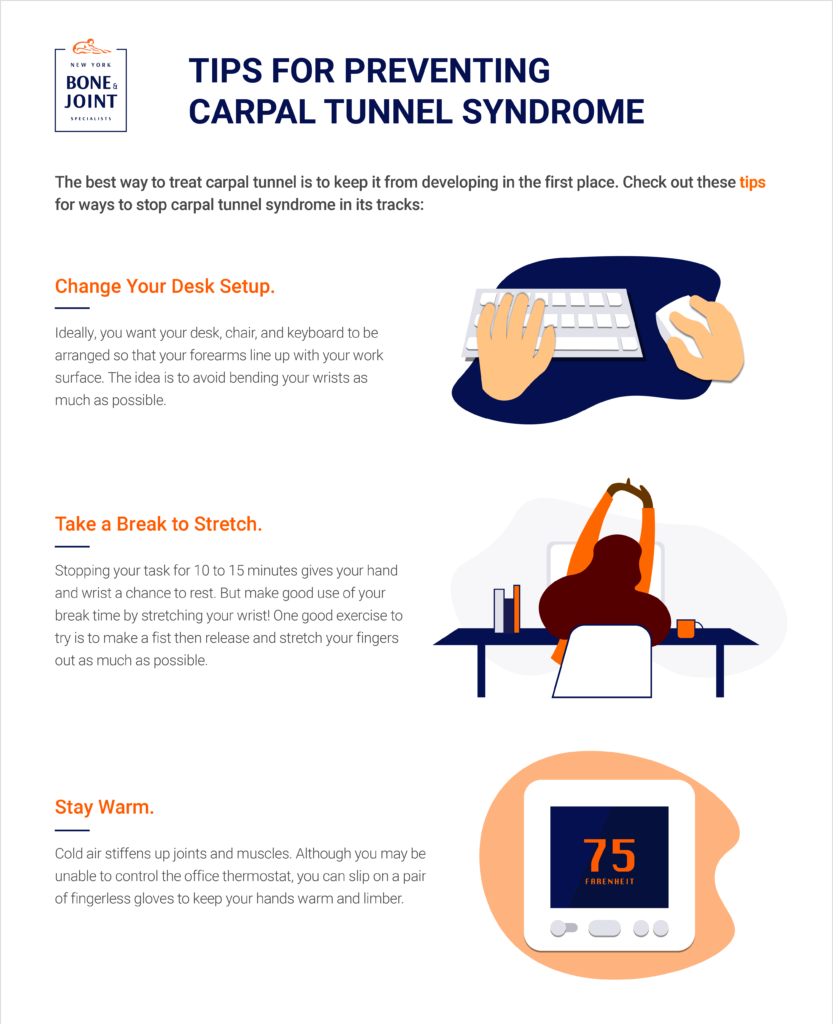Carpal tunnel can be a painful and even debilitating orthopedic condition. But it’s one that can be prevented with some simple lifestyle changes.
Carpal tunnel syndrome, a progressive condition marked by pain, numbness and tingling in the hands and wrists, is an extremely common condition. While it is most often associated with typing on a computer, carpal tunnel syndrome can strike anyone who performs repetitive tasks with their hands, such as cashiers, knitters, and assembly line workers. Or it can occur after an injury to the wrist or hand. Some pre-existing conditions, like diabetes and rheumatoid arthritis, are also associated with a greater incidence of carpal tunnel syndrome. Additionally, women tend to suffer from the condition at higher rates than men because their carpal tunnels are smaller.
That’s relevant to the condition because, as the name suggests, carpal tunnel syndrome is directly related to the carpal tunnel. In carpal tunnel syndrome, your median nerve, which spans the length of your arm and ends in the wrist, becomes compressed due to any of the reasons described above. That median nerve passes through the carpal tunnel, a narrow pathway of bone and ligament at the base of your hand, which is the reason for the condition’s name. Because the nerve controls the movements of your fingers apart from the pinky, the first sign of carpal tunnel syndrome is typically a tingling or numb sensation in the fingers. Some people may also experience pain and a burning sensation radiating up their arm to their elbow in addition to a weak grip.
6 Tips to Prevent Carpal Tunnel Syndrome
Obviously it is best to avoid carpal tunnel syndrome if at all possible. The good news is that you don’t have to switch jobs or give up your hobbies to avoid carpal tunnel syndrome. You can take measures to ward off the condition before the pain starts. Check out these 6 tips for ways to stop carpal tunnel syndrome in its tracks:

Go for a Neutral Wrist Position. Avoid bending your wrists sharply up or down whenever possible, including when you’re at work or simply in your daily life. Such exaggerated positions stress the nerve. Lift the pressure off by keeping your wrist in a straight, neutral alignment.
Lighten Up. You probably don’t realize it, but you may be striking your keyboard too hard. Go for a lighter touch and relax your hand and wrist as you type.
Take a Break to Stretch. Stopping your task for 10 to 15 minutes gives your hand and wrist a chance to rest. But make good use of your break time by stretching your wrist! One good exercise to try is to make a fist then release your fingers and fan them out. Stretch them as far as possible. Repeat 5 to 10 times.
Switch Hands. If you always perform a task with one hand, switch to the other if you can. This gives each hand and wrist a break from a continual and stressful motion. Of course this isn’t always possible, but make a point of switching wherever you can.
Change Your Desk Setup. How your desk and chair are arranged may be causing extra strain on your wrists. Ideally, you want your desk, chair, and keyboard to be arranged so that your forearms line up with your work surface. The idea is to avoid bending your wrists as much as possible. Also try to keep your elbows tucked to your sides when working at a desk.
Stay Warm. Cold air stiffens up joints and muscles. Although you may be unable to control the office thermostat, you can slip on a pair of fingerless gloves to keep your hands warm and limber.
Treating Carpal Tunnel Syndrome
If you suspect you have carpal tunnel syndrome, it’s time to go to the orthopedist for a proper diagnosis and treatment. Your orthopedist will begin by performing a number of physical tests to assess any nerve damage. Once they’ve assessed the extent of the condition, treatment can begin.
Carpal tunnel syndrome treatments typically begin with recommendations of conservative therapies including:
- Avoiding repetitive motions for two weeks or more.
- Applying ice packs to reduce swelling.
- Taking non-steroidal anti-inflammatories medications.
- Wearing a brace for four to six weeks to keep the hand and wrist immobile.
- Working with a physical therapist on strengthening and stretching exercises after pain subsides.
In severe cases not helped by conservative treatments, your doctor may recommend carpal release surgery. In this procedure, the transverse carpal ligament is dissected to release pressure on the median nerve and enlarge the carpal tunnel.
Don’t Live with Wrist Pain
Healthy hands and wrists are critical when it comes to performing important functions in your everyday life. So don’t let pain stop you from doing your job or enjoying your hobbies! If you believe you may have carpal tunnel syndrome, it’s important to see a specialist right away to get to the bottom of the condition. The orthopedists at New York Bone & Joint Specialists can diagnose your condition and discuss treatment options with you to get you pain-free once again. Contact us today for a consultation.




